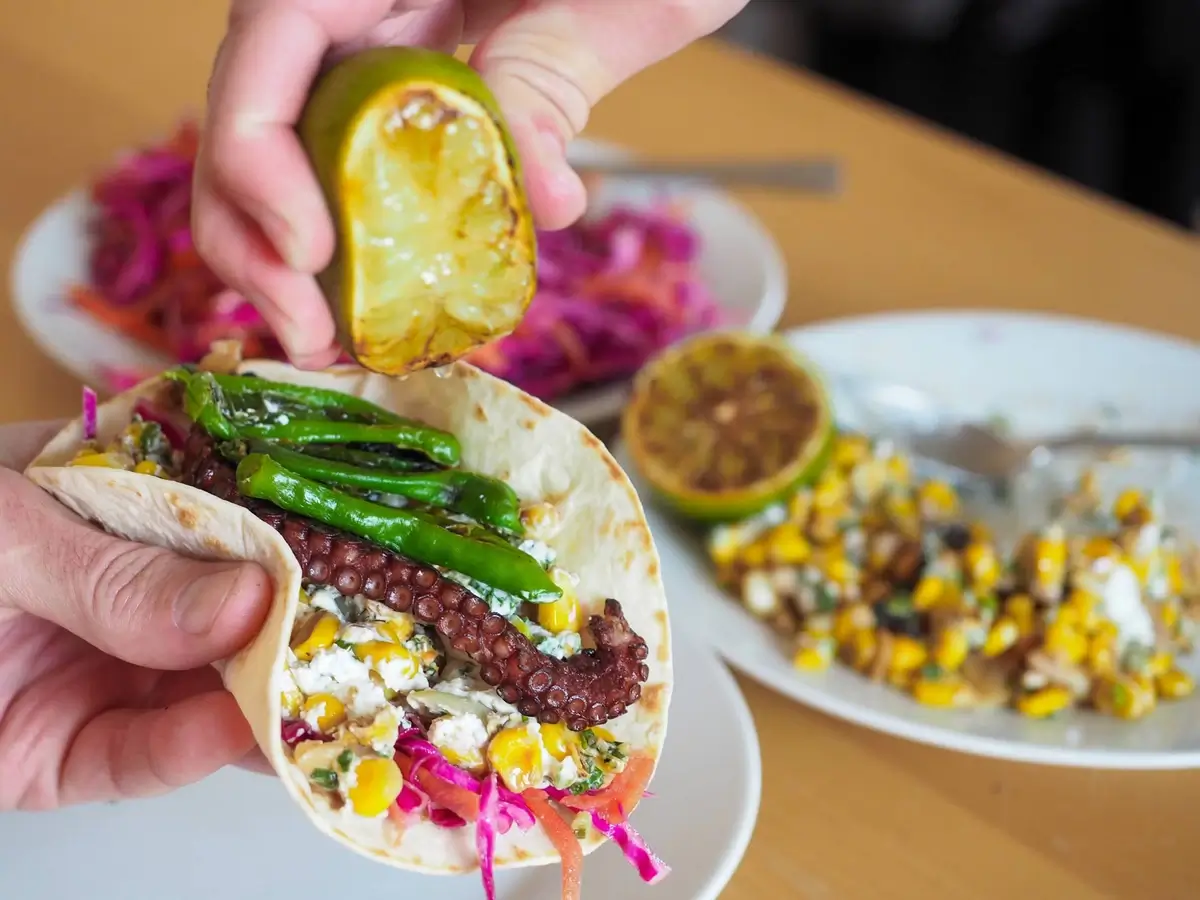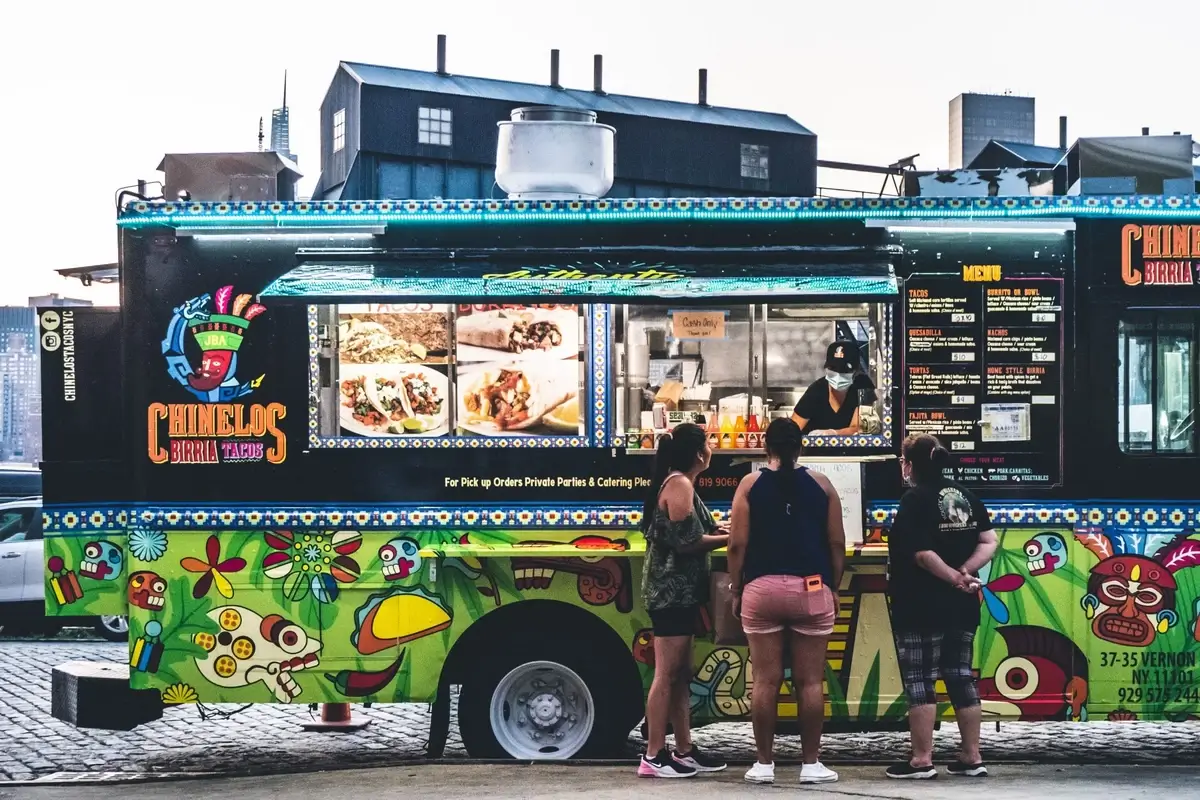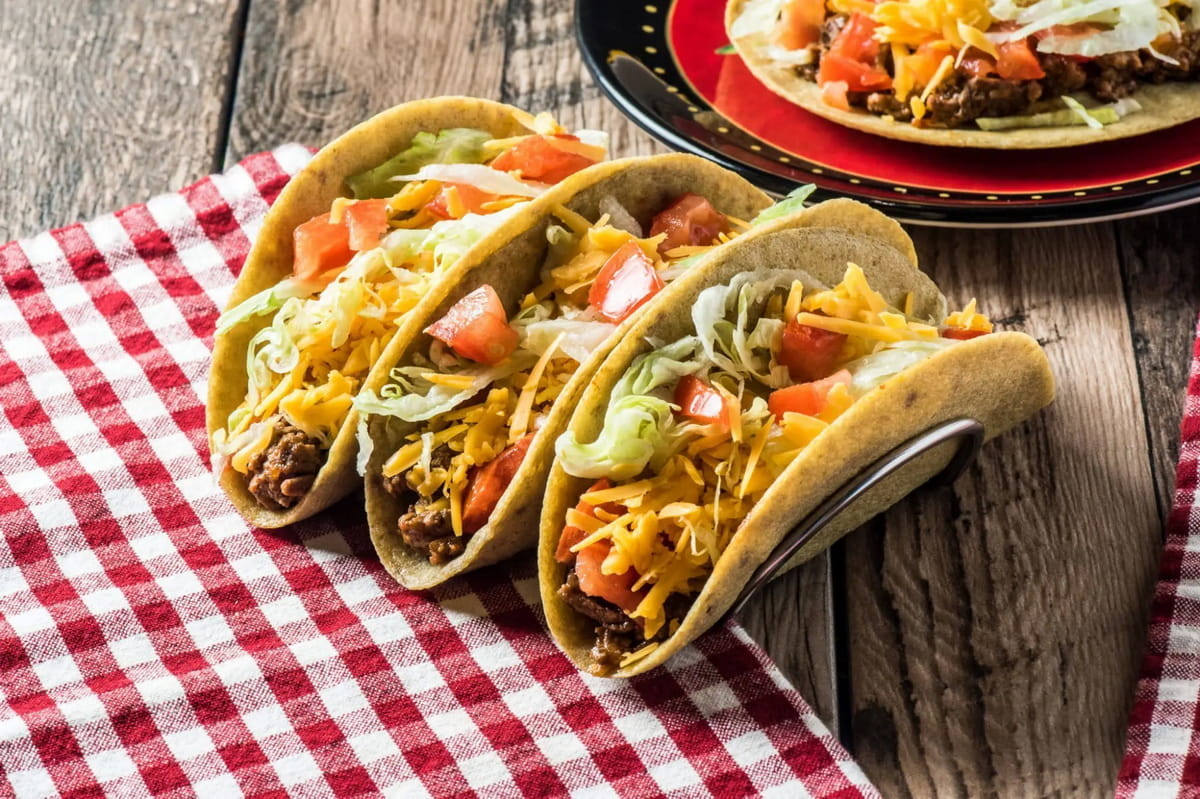Tacos, a culinary gem from Mexico, have a story as flavorful as their varied fillings. Tracing back to pre-Columbian times, these delightful dishes were originally simple corn tortillas filled with small fish. Fast forward to today, and tacos have transformed into a global phenomenon. In the U.S. alone, an astounding 4.5 billion tacos are consumed each year. The record for the longest taco, measuring a remarkable 2.5 kilometers, was set in Guadalajara.
From their historic roots to modern-day records and variations, this article is packed with fun facts about tacos to satisfy your curiosity and appetite.
1. Origins of Tacos: A Journey Through Time
The humble taco, a staple of Mexican cuisine, has roots stretching back to the times of the Aztecs. Contrary to popular belief, tacos aren’t a modern invention but a traditional dish that has evolved over centuries. Originally, tacos were simple: just a corn tortilla filled with small fish.
These early tacos were a practical, portable meal for Mexican miners in the 18th century, symbolizing a blend of indigenous and colonial influences. The name “taco” itself is thought to have originated from the Nahuatl word ‘tlahco’, meaning “half” or “in the middle,” referring to how it is formed.
2. The World’s Most Expensive Taco: Luxury on a Plate
In the world of high-end cuisine, tacos have made a surprising entry. The world’s most expensive taco, priced at $25,000, was created at the Grand Velas Los Cabos Resort in Mexico. This luxurious taco features premium ingredients like Kobe beef, Almas Beluga caviar, black truffle brie cheese, and is served on a gold-infused corn tortilla.
Topped with an exotic salsa made of dried Morita chili peppers and Ley .925 ultra-premium añejo tequila, this taco is a testament to culinary extravagance and innovation, merging traditional flavors with opulent twists.

Image: luxsphere.co
3. Taco Varieties: More Than Just Beef and Cheese
Tacos are a canvas for culinary creativity, offering endless possibilities beyond the classic beef and cheese. Each region in Mexico boasts its unique taco variety, like Tacos al Pastor, which originated from Lebanese immigrants in Mexico, adapting their shawarma to local tastes. Then there’s the Baja region, known for its fish tacos, a blend of fresh seafood and Mexican flavors.
The diversity extends globally, with Korean-Mexican fusion tacos incorporating kimchi and bulgogi, exemplifying how tacos are a universal language of flavor, adaptable to countless cultural palates.

Image: Britannica
4. Tacos in Space: An Astronaut’s Delight
Believe it or not, tacos have even made it into space! Astronauts aboard the International Space Station have enjoyed tacos as a part of their diet, thanks to the space food research and development.
These aren’t your ordinary tacos, though. Space tacos are made with specially prepared ingredients to ensure they are safe and easy to eat in zero gravity. This includes using tortillas instead of bread to avoid crumbs.
The inclusion of tacos in space menus highlights their versatility and universal appeal, even in the most extraordinary environments.
5. Record-Breaking Tacos: The Longest Taco Ever Made
Tacos aren’t just about taste; they’re also about breaking records. The longest taco ever made measured a staggering 2.5 kilometers (1.55 miles) in length! This culinary feat was achieved in Guadalajara, Mexico, in 2015. Hundreds of chefs and volunteers came together to create this enormous taco, showcasing the deep communal spirit that tacos embody.
This event not only set a world record but also celebrated Mexican culture and cuisine, highlighting the taco’s ability to bring people together in both enjoyment and achievement.

Image: avax.news
6. Taco Day: A Global Celebration of Flavor
Taco Day, celebrated on October 4th annually, is not just a day for taco enthusiasts but a cultural phenomenon. This special day originated in the United States but quickly spread globally, reflecting the universal love for this Mexican dish. In the U.S. alone, Americans consume over 4.5 billion tacos a year, according to NationalTacoDay.com.
On Taco Day, restaurants and taco trucks often report a significant surge in sales, with promotions and taco-themed events highlighting the diversity and creativity in taco preparation.
It’s a day that transcends geographical boundaries, uniting people over their shared love for this versatile dish.
7. Tacos in Pop Culture: More Than Just Food
Tacos in Pop Culture have evolved beyond a food item to a cultural symbol, permeating various media forms. The phrase “Taco Tuesday” became a staple in American culture, illustrating the dish’s influence beyond the culinary world.
In movies, like the “Lego Movie,” tacos are depicted as a fun, universally loved food, reinforcing their cultural significance. On TV, shows like “Breaking Bad” used tacos to set scenes and build character depth.
Social media platforms see a flurry of taco-related posts, with Instagram boasting millions of taco hashtags, reflecting their role in digital culture and community building.
8. Nutritional Facts: Health Benefits of Tacos
Nutritional Facts of Tacos reveal that they can be a healthy food choice when prepared with the right ingredients. A study by the Journal of Nutrition and Food Sciences suggests that tacos made with fresh, whole ingredients can offer a balanced diet.
Lean proteins like grilled chicken, fish, or beans, combined with fresh veggies, provide essential nutrients and fibers. Whole-grain or corn tortillas are a healthier alternative to refined flour tortillas, contributing to the overall nutritional value.
The versatility of tacos allows for dietary adaptations, such as low-calorie and vegetarian options, making them suitable for a variety of eating plans.
9. Tacos Around the World: International Twists
Tacos Around the World have taken on diverse forms, reflecting the fusion of global culinary traditions.
In Japan, the concept of “taco rice,” born in Okinawa, combines ground beef, lettuce, cheese, and rice, a fusion of Mexican and Japanese cuisine. In India, tacos meet traditional spices and fillings like tandoori chicken, offering a spicy twist. In Europe, particularly in places like Norway and Germany, tacos have been adapted to local tastes, often served on Fridays, known as “Fredagstaco” in Norway.
These variations not only showcase global appreciation but also the adaptability of tacos to different cultural palates and ingredients.

Image: The Japan Times
10. The Evolution of Taco Shells: A Crunchy History
The Evolution of Taco Shells is a tale of culinary innovation. While traditional Mexican tacos predominantly used soft corn tortillas, the introduction of hard-shell tacos marks a significant moment in taco history.
The hard-shell taco, popularized in the United States around the 1950s, was a response to preserving the tortillas longer. Glen Bell, the founder of Taco Bell, is often credited with commercializing the hard-shell taco, which led to its widespread popularity.
This evolution reflects the adaptability of tacos, blending traditional methods with new techniques to suit different tastes and needs.
11. Taco Trucks: The Rise of Mobile Mexican Cuisine
Taco Trucks represent the democratization of gourmet food, making delicious meals accessible to a broader audience. The rise of taco trucks can be traced back to the 1970s in Los Angeles, where they started as a simple, affordable means for Mexican immigrants to share their cuisine.
Over the decades, these mobile eateries have become cultural icons in urban landscapes, often featuring fusion and gourmet tacos, and playing a significant role in the food truck revolution. The LA-based Kogi Korean BBQ truck, for example, sparked a new wave of interest in fusion tacos, combining Korean and Mexican flavors.

Image: HopDes
12. Salsa and Tacos: A Match Made in Culinary Heaven
Salsa and Tacos go hand in hand, each complementing the other to create a perfect balance of flavors. The history of salsa, a blend of indigenous Mesoamerican and Spanish influences, dates back to the Aztecs, but it gained worldwide popularity alongside tacos.
Salsas range from mild to fiery, with ingredients like tomatoes, chilies, onions, and herbs. A study in the “Journal of Culinary Science & Technology” suggests that the right salsa can enhance the flavor profile of a taco, making it a crucial component of the taco-eating experience.
13. Tacos in the Movies: Iconic Cinematic Moments
Tacos in the Movies have had their share of iconic moments, often serving as a cultural touchstone. From comedies to dramas, tacos have been featured in scenes that resonate with audiences, like the taco dinner in “Breaking Bad” or the taco truck in “Ant-Man.”
These moments not only provide relatability but also reflect the integral role of tacos in American culture. The presence of tacos in cinema underscores their status as more than just a food item, but as a symbol of everyday life and community.
14. Economic Impact of the Taco Industry
The taco industry’s economic footprint is immense in the United States. As per IBISWorld’s analysis, the broader Mexican restaurant sector, significantly driven by taco sales, generates over $60 billion in annual revenue. This figure is bolstered by both ubiquitous fast-food chains and local taco shops, each contributing to the industry’s growth. Notably, tacos account for a substantial portion of this revenue, underscoring their popularity.
Employment opportunities in this sector are diverse, spanning from agricultural roles in food production to culinary positions in kitchens, and customer service roles in front-of-house operations. The industry’s economic relevance is particularly pronounced in regions with strong Mexican and Tex-Mex culinary traditions, where it serves as a vital economic pillar supporting local communities. This economic dynamism underscores tacos’ significance beyond gastronomy, marking them as a key player in the food industry.
FAQ
Why are tacos called tacos?
The term “taco” originates from the Nahuatl word ‘tlahco’, which means “half” or “in the middle.” This is believed to refer to the way the tortilla is folded around the filling. The name became associated with the dish during the 18th century in the silver mines of Mexico, where the word “taco” was used to describe small explosives miners used, which were pieces of paper wrapped around gunpowder. The similarity between these wrapped explosives and the wrapped tortillas led to the popularization of the term for this iconic Mexican dish.
What are some facts about the history of tacos?
The history of tacos dates back to pre-Columbian times in Mexico, where indigenous people in the Lake Region of the Valley of Mexico traditionally ate tacos filled with small fish. These early tacos were a practical, portable meal for miners and workers. With the Spanish colonization and cultural mixing, the variety of taco fillings expanded. By the 20th century, tacos had begun to spread across the United States, leading to the development of different regional varieties and the rise of taco chains like Taco Bell, founded by Glen Bell in the 1960s.
What makes tacos unique?
Tacos are unique because of their versatility and adaptability. They can be made with a wide variety of fillings, including beef, chicken, seafood, vegetables, and cheese, accommodating diverse dietary preferences and cultural influences. Tacos also differ regionally, reflecting local tastes and ingredients. Their simplicity in preparation and the ability to be eaten without utensils make them a popular street food. Additionally, the combination of flavors and textures – from the soft or crunchy tortilla to the spicy, savory, or sweet fillings – offers a unique and customizable eating experience.
Who ate the most tacos?
Determining who ate the most tacos is challenging as it’s a record that could vary based on different criteria like time limit, taco size, or type. However, in competitive eating, Joey Chestnut holds a notable record. In 2017, at the Taco Eating Championship in San Jose, Chestnut set a record by eating 126 tacos in 8 minutes. This feat showcases the extremes of competitive eating and the popularity of tacos in such events.
Who made tacos famous?
Tacos were made famous in the United States largely due to the influence of Mexican immigrants and the entrepreneurial efforts of individuals like Glen Bell. Bell, the founder of Taco Bell, played a significant role in popularizing tacos among the American public. He helped transform the taco from a traditional Mexican street food to a mainstream fast-food item. His chain, Taco Bell, founded in the 1960s, rapidly expanded, introducing tacos and Mexican-inspired cuisine to a wide audience in the U.S.
How big was the biggest taco ever?
The biggest taco ever made was recorded in 2015 in Guadalajara, Mexico. This record-breaking taco measured a remarkable 2.5 kilometers (1.55 miles) in length. This enormous culinary creation was the result of a collaborative effort involving hundreds of chefs and volunteers. It was an impressive showcase of Mexican culinary tradition and community spirit, emphasizing the taco’s role as a unifying cultural element in celebrations and record-setting endeavors.





